
Christinus marmoratus, also known as marbled gecko or southern marbled gecko, is a species of Gekkonidae (gecko) native to southern mainland of Australia, from Victoria to Western Australia. The species is well adapted to a variety of habitats, including city dwellings..

The coral catshark is a species of catshark in the family Scyliorhinidae. It is common on shallow coral reefs across the Indo-West Pacific, from Pakistan to New Guinea. Reaching up to 70 cm (28 in) in length, the coral catshark has an extremely slender body, a short head and tail, and two dorsal fins that are angled backwards. It can be identified by the numerous black and white spots on its back, sides, and fins, which often merge to form horizontal bars. Furthermore, adult males have distinctively long and thin claspers.

Amolops marmoratus is a species of ranid frog found in Asia. Its common names include marbled sucker frog, marbled cascade frog, Pegu torrent frog, and many others. The taxonomic status of many populations formerly assigned to this species is uncertain.

The marbled newt is a mainly terrestrial newt native to western Europe. They are found in the Iberian Peninsula and France, where they typically inhabit mountainous areas.
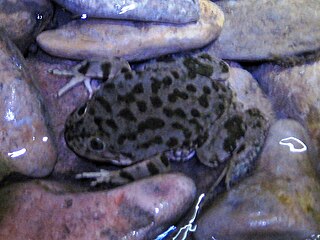
Telmatobius marmoratus, the marbled water frog, is a vulnerable species of frog in the family Telmatobiidae. The most widespread species in the genus, it is found in the Andean highlands of Bolivia, northern Chile and southern Peru. It may also occur in northwestern Argentina, but the taxonomic position of this population is unclear. This semiaquatic frog is found in and near streams, rivers, waterfalls, lakes and ponds.

The mangrove rivulus or mangrove killifish, Kryptolebias marmoratus, is a species of killifish in the family Rivulidae. It lives in brackish and marine waters along the coasts of Florida, through the Antilles, and along the eastern and northern Atlantic coasts of Mexico, Central America and South America. It has a very wide tolerance of both salinity and temperature, can survive for about two months on land, and mostly breeds by self-fertilization. It is typically found in areas with red mangrove and sometimes lives in burrows of Cardisoma guanhumi crabs.

Salmo marmoratus, the marble trout, is a species of freshwater fish in the family Salmonidae. It is characterized by a distinctive marbled color pattern and high growth capacity. The marble trout is found in only a handful of drainages and rivers of the Adriatic basin in Italy, Slovenia, Croatia, Bosnia and Herzegovina, and Montenegro, while in Albania, the species is considered most likely extirpated.

Pachygrapsus marmoratus is a species of crab, sometimes called the marbled rock crab or marbled crab, which lives in the Black Sea, the Mediterranean Sea and parts of the Atlantic Ocean. It is dark violet brown, with yellow marbling, and with a body up to 36 millimetres (1.4 in) long. A semiterrestrial omnivore, it feeds on algae and various animals including mussels and limpets.
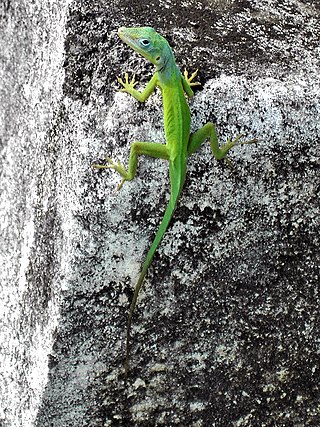
Anolis marmoratus, commonly known as the leopard anole, Guadeloupe anole, or Guadeloupean anole, is a species of anole that is endemic to the islands of Guadeloupe, in the Caribbean Lesser Antilles.
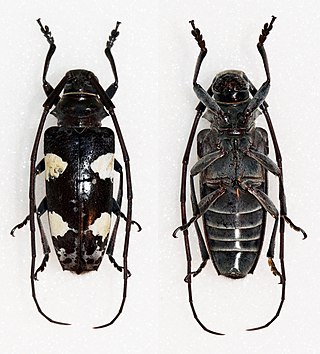
Blepephaeus is a genus of longhorn beetles of the subfamily Lamiinae, containing the following species:
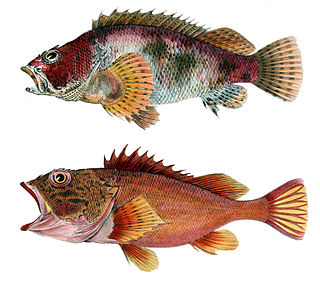
Sebastiscus marmoratus, the sea ruffe, false kelpfish or dusky stingfish, is a species of marine ray-finned fish belonging to the subfamily Sebastinae, the rockfishes, part of the family Scorpaenidae. It is found in the Western Pacific from southern Japan to the Philippines. It has also been sighted twice in Australia.
Blepephaeus andamanicus is a species of beetle in the family Cerambycidae. It was described by Stephan von Breuning in 1935. It is known from the Andaman Islands.
Blepephaeus indicus is a species of beetle in the family Cerambycidae. It was described by Stephan von Breuning in 1935. It is known from India.
Blepephaeus lemoulti is a species of beetle in the family Cerambycidae. It was described by Stephan von Breuning in 1938. It is known from Laos.

Blepephaeus irregularis is a species of beetle in the family Cerambycidae. It was described by Heller in 1915. It is known from the Philippines. It contains the varietas Blepephaeus irregularis var. alboreductus.
Blepephaeus puae is a species of beetle in the family Cerambycidae. It was described by Lin in 2011. It is known from China.
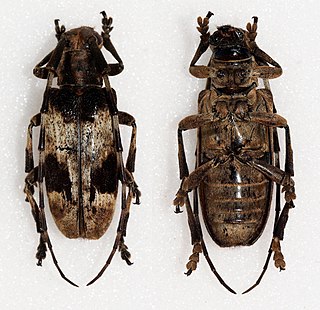
Blepephaeus succinctor is a species of beetle in the family Cerambycidae. It was described by Louis Alexandre Auguste Chevrolat in 1852, originally under the genus Monohammus. It is known from Malaysia, India, Sumatra, Myanmar, Taiwan, China, Thailand, and Vietnam. It feeds on Acacia confusa, Albizia chinensis, Firmiana simplex, Melia azedarach, Morus alba, and Vernicia fordii.
Blepephaeus undulatus is a species of beetle in the family Cerambycidae. It was described by Maurice Pic in 1930.












